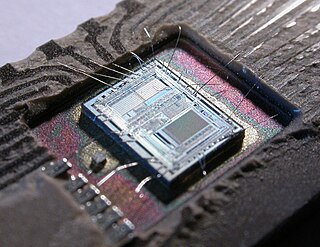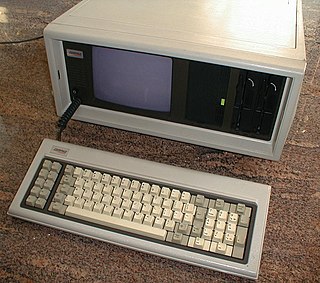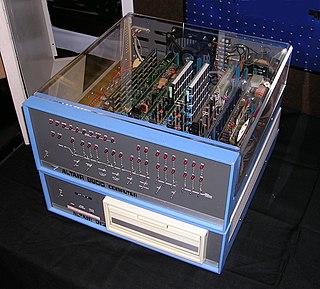Related Research Articles
Kermit is a computer file transfer and management protocol and a set of communications software tools primarily used in the early years of personal computing in the 1980s. It provides a consistent approach to file transfer, terminal emulation, script programming, and character set conversion across many different computer hardware and operating system platforms.

A microcontroller or microcontroller unit (MCU) is a small computer on a single integrated circuit. A microcontroller contains one or more CPUs along with memory and programmable input/output peripherals. Program memory in the form of NOR flash, OTP ROM, or ferroelectric RAM is also often included on the chip, as well as a small amount of RAM. Microcontrollers are designed for embedded applications, in contrast to the microprocessors used in personal computers or other general-purpose applications consisting of various discrete chips.
Stanley Bootle, known as Stan Kelly-Bootle, was a British author, academic, singer-songwriter and computer scientist.

IBM PC–compatible refers to a class of computers that are technically similar to the original IBM PC from 1981 of computer giant IBM. Like the original IBM PC, they use the Intel x86 architecture and are capable of using interchangeable commodity hardware, such as expansion cards. Initially such computers were referred to as PC clones, IBM clones or IBM PC clones, but the term "IBM PC compatible" is now a historical description only, since the vast majority of microcomputers today ever since the 1990s are IBM compatible, but also because IBM no longer sell personal computers anyway, having sold its division to Lenovo in 2005. "Wintel" is a similar description that is more commonly used for modern computers.

The Altair 8800 is a microcomputer designed in 1974 by MITS and based on the Intel 8080 CPU. Interest grew quickly after it was featured on the cover of the January 1975 issue of Popular Electronics and was sold by mail order through advertisements there, in Radio-Electronics, and in other hobbyist magazines. According to Harry Garland, the Altair 8800 was the product that catalyzed the microcomputer revolution of the 1970s. It was the first commercially successful personal computer. The computer bus designed for the Altair was to become a de facto standard in the form of the S-100 bus, and the first programming language for the machine was Microsoft's founding product, Altair BASIC.

Leopoldstadt is the 2nd municipal district of Vienna in Austria. As of 1 January 2016, there are 103,233 inhabitants over 19.27 km2 (7 sq mi). It is situated in the heart of the city and, together with Brigittenau, forms a large island surrounded by the Danube Canal and, to the north, the Danube. It is named after Leopold I, Holy Roman Emperor. Due to its relatively high percentage of Jewish inhabitants before the Holocaust, Leopoldstadt gained the nickname Mazzesinsel. This context was a significant aspect for the district twinning with the New York City borough Brooklyn in 2007.

The Berenstain Bears is a children's literature franchise created by Stan and Jan Berenstain and continued by their son, Mike Berenstain. The books feature a family of anthropomorphic grizzly bears who generally learn a moral or safety-related lesson in the course of each story.

Erica Jong is an American novelist, satirist, and poet, known particularly for her 1973 novel Fear of Flying. The book became famously controversial for its attitudes towards female sexuality and figured prominently in the development of second-wave feminism. According to The Washington Post, it has sold more than 20 million copies worldwide, while by 2022, the New York Times claimed that it had sold more than 37 million copies worldwide.

Russell Conwell Hoban was an American writer. His works span many genres, including fantasy, science fiction, mainstream fiction, magical realism, poetry, and children's books. He lived in London from 1969 until his death.

Roy William Thomas Jr. is an American comic book writer and editor. He was Stan Lee's first successor as editor-in-chief of Marvel Comics and possibly best known for introducing the pulp magazine hero Conan the Barbarian to American comics. Thomas is also known for his championing of Golden Age comic-book heroes – particularly the 1940s superhero team the Justice Society of America – and for lengthy writing stints on Marvel's X-Men and The Avengers, and DC Comics' All-Star Squadron, among other titles.

Steven Levy is an American journalist and editor at large for Wired who has written extensively for publications on computers, technology, cryptography, the internet, cybersecurity, and privacy. He is the author of the 1984 book Hackers: Heroes of the Computer Revolution, which chronicles the early days of the computer underground. Levy published eight books covering computer hacker culture, artificial intelligence, cryptography, and multi-year exposés of Apple, Google, and Facebook. His most recent book, Facebook: The Inside Story, recounts the history and rise of Facebook from three years of interviews with employees, including Chamath Palihapitiya, Sheryl Sandberg, and Mark Zuckerberg.

Retrocomputing is the current use of older computer hardware and software. Retrocomputing is usually classed as a hobby and recreation rather than a practical application of technology; enthusiasts often collect rare and valuable hardware and software for sentimental reasons.

Busicom Co., Ltd. was a Japanese company that manufactured and sold computer-related products headquartered in Taito, Tokyo. It owned the rights to Intel's first microprocessor, the Intel 4004, which they created in partnership with Intel in 1970.

Stephen R. Bissette is an American comic book artist and publisher with a focus on the horror genre. He worked with writer Alan Moore and inker John Totleben on the DC Comics series Swamp Thing in the 1980s.

Richard Bache Ayers was an American comic book artist and cartoonist best known for his work as one of Jack Kirby's inkers during the late-1950s and 1960s period known as the Silver Age of Comics, including on some of the earliest issues of Marvel Comics' The Fantastic Four. He is the signature penciler of Marvel's World War II comic Sgt. Fury and his Howling Commandos, drawing it for a 10-year run, and he co-created Magazine Enterprises' 1950s Western-horror character the Ghost Rider, a version of which he would draw for Marvel in the 1960s.

Robert J. Mical is an American computer programmer and hardware designer who has primarily worked in video games. He is best known for creating the user interface, Intuition, for Commodore's Amiga personal computer (1985), contributing to the design of the Amiga hardware, and co-designing, with Dave Needle, the Atari Lynx color handheld (1989) and the 3DO Interactive Multiplayer (1993).

Frank James Butterfield, was Canadian computer programmer, author, and television personality known for his work with early microcomputers. He is particularly noted for associations with Commodore Business Machines and the Toronto PET Users Group, for many books and articles on machine language programming, and for educational videos and TV programs.

The Cromemco Dazzler was a graphics card for S-100 bus computers introduced in a Popular Electronics cover story in 1976. It was the first color graphics card available for microcomputers. The Dazzler was the first of a succession of increasingly capable graphics products from Cromemco which, by 1984, were in use at 80% of all television stations in the U.S. for the display of weather, news, and sports graphics.

The Ballistic Research Laboratory (BRL) was a research facility under the U.S. Army Ordnance Corps and later the U.S. Army Materiel Command that specialized in ballistics as well as vulnerability and lethality analysis. Situated at Aberdeen Proving Ground, Maryland, BRL served as a major Army center for research and development in technologies related to weapon phenomena, armor, accelerator physics, and high-speed computing. In 1992, BRL was disestablished, and its mission, personnel, and facilities were incorporated into the newly created U.S. Army Research Laboratory (ARL).

The TMS1000 is a family of microcontrollers introduced by Texas Instruments in 1974.
References
- ↑ Augarten 1984.
- ↑ Letters, Columbia Magazine, Winter 2007/8
- ↑ LibraryThing
Sources
- Augarten, Stan (1984). Bit by Bit: An Illustrated History of Computers . New York: Ticknor & Fields. ISBN 978-0899193021.